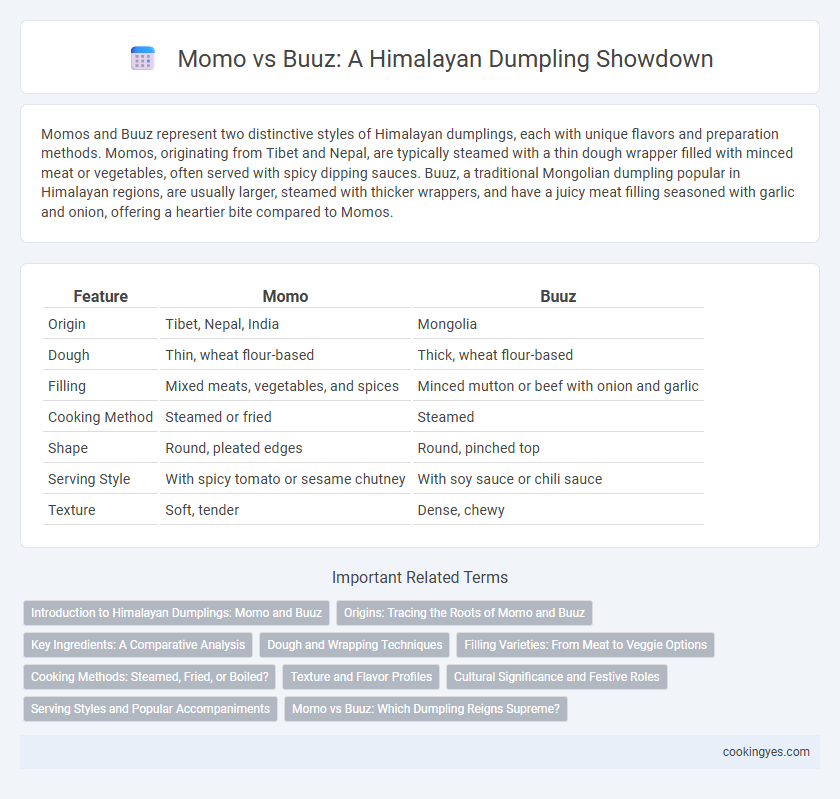Momos and Buuz represent two distinctive styles of Himalayan dumplings, each with unique flavors and preparation methods. Momos, originating from Tibet and Nepal, are typically steamed with a thin dough wrapper filled with minced meat or vegetables, often served with spicy dipping sauces. Buuz, a traditional Mongolian dumpling popular in Himalayan regions, are usually larger, steamed with thicker wrappers, and have a juicy meat filling seasoned with garlic and onion, offering a heartier bite compared to Momos.
Table of Comparison
| Feature | Momo | Buuz |
|---|---|---|
| Origin | Tibet, Nepal, India | Mongolia |
| Dough | Thin, wheat flour-based | Thick, wheat flour-based |
| Filling | Mixed meats, vegetables, and spices | Minced mutton or beef with onion and garlic |
| Cooking Method | Steamed or fried | Steamed |
| Shape | Round, pleated edges | Round, pinched top |
| Serving Style | With spicy tomato or sesame chutney | With soy sauce or chili sauce |
| Texture | Soft, tender | Dense, chewy |
Introduction to Himalayan Dumplings: Momo and Buuz
Himalayan dumplings feature Momo, a Tibetan-Nepalese specialty known for its thin dough wrappers filled with spiced meat or vegetables, and Buuz, a traditional Mongolian dish distinguished by its thicker dough and savory lamb filling. Both dumplings are steamed and celebrated for their hearty, aromatic flavors that reflect the region's diverse culinary heritage. Momo offers a slightly delicate texture with garlic and ginger notes, while Buuz provides a richer, meat-forward experience often enjoyed during Mongolian festivals.
Origins: Tracing the Roots of Momo and Buuz
Momo originates from Tibetan and Nepalese cuisine, deeply rooted in Himalayan culture with influences from Tibetan Buddhism and Himalayan trade routes. Buuz, on the other hand, is a traditional Mongolian dumpling, shaped by nomadic herding lifestyles and Mongolian culinary customs. Both dumplings reflect their distinct regional heritages, showcasing unique fillings and preparation methods tied to their origins.
Key Ingredients: A Comparative Analysis
Momo and Buuz are traditional Himalayan dumplings distinguished by their key ingredients; Momo typically features finely minced meat such as chicken, pork, or beef mixed with cabbage, ginger, garlic, and onions, whereas Buuz incorporates ground mutton or beef combined with scallions, garlic, and occasionally soy sauce for a richer flavor profile. The dough for both dumplings is made from all-purpose flour and water but varies slightly in thickness, with Momo often showcasing a thinner, more delicate wrapper compared to the sturdier Buuz casing designed to hold juicier fillings. The inclusion of spices and herbs such as cilantro in Momo contrasts with the simplistic seasoning approach in Buuz, emphasizing the diverse culinary traditions within the Himalayan region.
Dough and Wrapping Techniques
Momo dough is typically softer and thinner, made with all-purpose flour and water, resulting in a delicate texture that complements the flavorful fillings. Buuz dough is slightly thicker and more elastic, crafted to withstand steaming without losing shape, often achieved by kneading with hot water. Wrapping techniques differ as momo are pleated into intricate, flower-like shapes to seal the filling, while buuz have a simpler, pinched top closure designed to retain juiciness during cooking.
Filling Varieties: From Meat to Veggie Options
Momo and Buuz, popular Himalayan dumplings, offer diverse filling varieties that cater to different tastes. Momo fillings range from traditional ground yak, chicken, or pork to vegetarian options like spinach, cabbage, and paneer, reflecting Tibetan and Nepali culinary influences. Buuz typically feature minced beef or mutton, with occasional vegetable versions, emphasizing Mongolian and Tibetan meat-centric traditions.
Cooking Methods: Steamed, Fried, or Boiled?
Momo and Buuz are traditional Himalayan dumplings with distinctive cooking methods that influence their texture and flavor. Momo can be steamed, fried, or boiled, offering a versatile range of tastes from the soft, delicate steamed version to the crispy, golden fried variant. Buuz, primarily steamed, retain a juicy, tender interior that highlights their rich meat filling, reflecting the Tibetan culinary preference for steaming to preserve natural flavors.
Texture and Flavor Profiles
Momo features a soft, slightly chewy dough with a well-balanced filling of spiced meat or vegetables that delivers a savory and aromatic flavor profile typical to Tibetan and Nepali cuisine. Buuz offers a thicker, doughier texture that is more pillowy and dense, with a rich, juicy filling often seasoned with garlic and black pepper, reflecting traditional Mongolian tastes. Both dumplings showcase distinct regional textures and flavors, with momo leaning towards a lighter, spice-infused bite and buuz providing a heartier, robust experience.
Cultural Significance and Festive Roles
Momo and Buuz are iconic Himalayan dumplings with distinct cultural ties; Momo is widely celebrated in Nepal and Tibet, often associated with communal gatherings and festive occasions like Losar, the Tibetan New Year. Buuz, integral to Mongolian cuisine, holds ceremonial importance during Tsagaan Sar, the Mongolian lunar new year, symbolizing prosperity and family unity. Both dumplings serve as culinary embodiments of their respective cultures, reflecting traditional values and seasonal celebrations.
Serving Styles and Popular Accompaniments
Momo are traditionally served steamed or fried with a side of spicy tomato-based achar, enhancing their bold flavors, while Buuz are typically steamed and accompanied by a light soy dipping sauce or a simple vinegar mix to preserve their delicate taste. Momo often come in larger portions and are enjoyed with pickled vegetables, reflecting Nepali and Tibetan dining customs. Buuz, favored in Mongolian cuisine, are smaller and paired with hearty broths or mild condiments to complement their rich meat filling.
Momo vs Buuz: Which Dumpling Reigns Supreme?
Momos and Buuz are iconic Himalayan dumplings, each with distinct regional flavors and preparation styles that define their culinary identities. Momos, originating from Tibet and popular throughout Nepal, feature thin dough wrappers filled with spiced vegetables, chicken, or buffalo, often served with tangy tomato chutney. Buuz, traditional to Mongolia, use thicker dough and are typically stuffed with minced mutton or beef, steamed to preserve a rich, juicy filling, making the choice between the two a matter of preference for texture and taste authenticity.
Momo vs Buuz for Himalayan Dumplings Infographic

 cookingyes.com
cookingyes.com